Jigs and fixtures are essential tools in manufacturing, but do you know how they differ? Both improve precision and efficiency, yet they serve distinct functions. Jigs guide machining tools, while fixtures secure workpieces. Their roles are critical in optimizing production processes.
In this article, we’ll define what jigs and fixtures are, discuss their differences, and explore their roles in manufacturing. You'll learn about various types, materials used, and their key applications across industries like automotive and aerospace. By the end, you'll see why these tools are indispensable for improving production efficiency and quality.
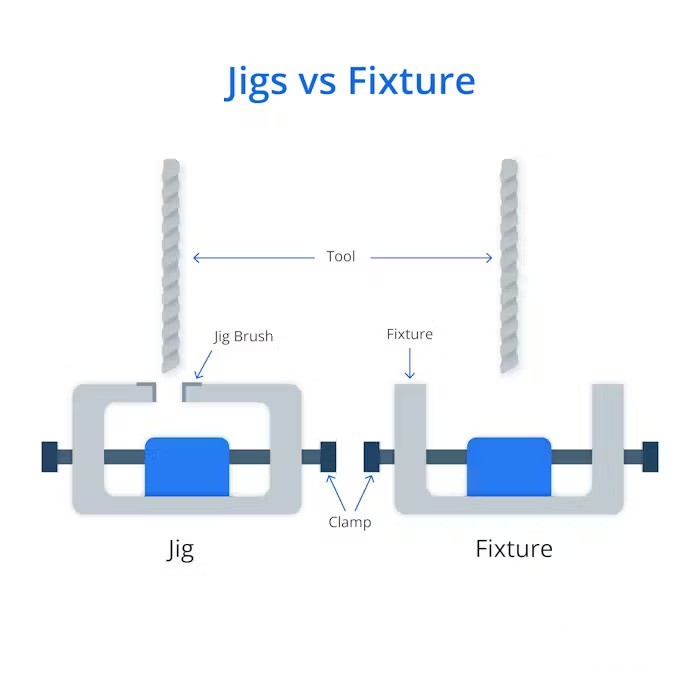
What are Jigs?
Jigs are specialized tools designed to enhance precision and efficiency in manufacturing processes. They serve as guiding mechanisms for cutting tools, ensuring consistent and accurate results across multiple workpieces.
Detailed Explanation of Jigs
Jigs consist of several key components:
Body: Main structure holding other elements
Locating elements: Position workpiece accurately
Guiding elements: Direct cutting tools
Clamping elements: Secure workpiece firmly
Bushings: Guide drill bits or other tools
These components work together to create a reliable system for repetitive machining operations.
Primary Function of Jigs in Manufacturing
Jigs primarily:
Guide cutting tools precisely
Ensure consistent positioning of workpieces
Reduce setup time between operations
Minimize human error in machining processes
Increase production speed and efficiency
By performing these functions, jigs significantly improve manufacturing quality and productivity.
Common Applications of Jigs
Jigs find extensive use in various machining operations:
Drilling: Ensure accurate hole placement and depth
Reaming: Guide reamers for precise hole finishing
Tapping: Facilitate consistent thread creation
Boring: Direct boring tools for cylindrical hole production
Countersinking: Guide tools for creating recessed holes
Types of Jigs
Jigs come in various forms, each designed for specific manufacturing needs. Understanding these types helps optimize production processes.
Template Jigs
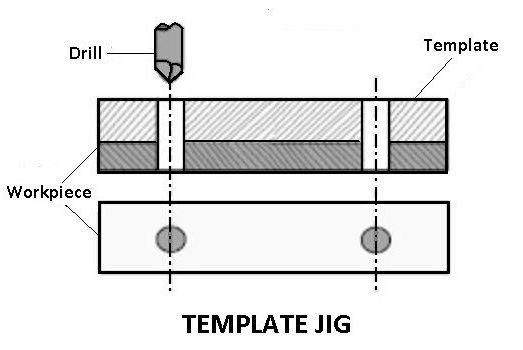
Simple yet effective, template jigs feature plates with holes serving as guides. They:
Provide basic guidance for drilling operations
Ensure consistent hole placement across multiple workpieces
Offer cost-effective solutions for small-scale production
Plate Jigs
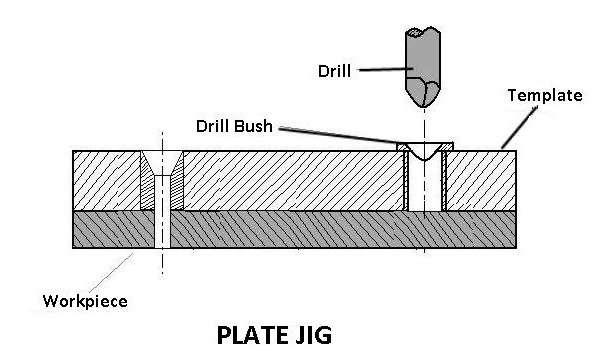
Plate jigs improve upon template designs by incorporating drill bushings. These jigs:
Allow precise drilling of large parts
Maintain accurate spacing between holes
Enhance durability longevity of the jig
Angle-plate Jigs
Designed for angled drilling operations, angle-plate jigs:
Hold parts at specific angles relative to mounting locators
Enable drilling at precise angles without complex setups
Increase efficiency in producing angled holes
Diameter Jigs

Specialized for cylindrical or spherical workpieces, diameter jigs:
Facilitate drilling of radial holes
Ensure consistency in hole placement around curved surfaces
Improve accuracy in circular component manufacturing
Channel Jigs

Featuring a channel-like cross-section, these jigs:
Allow easy fitting components within the channel
Provide secure positioning through knurled knob adjustments
Guide tools accurately through integrated drill bushings
Leaf Jigs
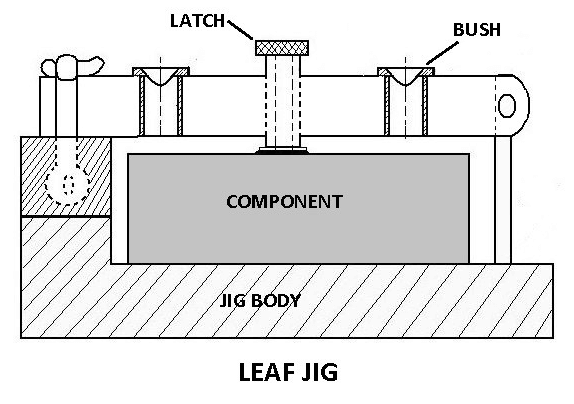
Leaf jigs incorporate a hinged design for improved workflow:
Enable quick loading and unloading of workpieces
Reduce setup time between operations
Enhance productivity in high-volume production environments
Ring Jigs
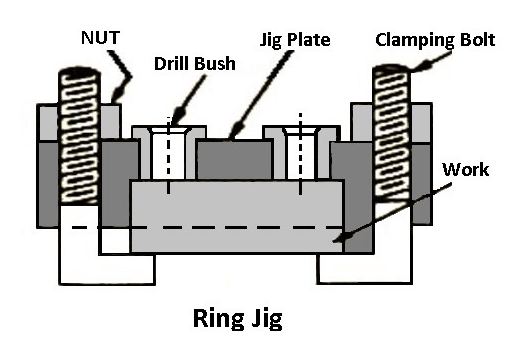
Specifically designed for circular flanged parts, ring jigs:
Secure work firmly to the drill body
Guide tools through precisely positioned drill bushes
Ensure accurate hole placement in circular patterns
Box Jigs
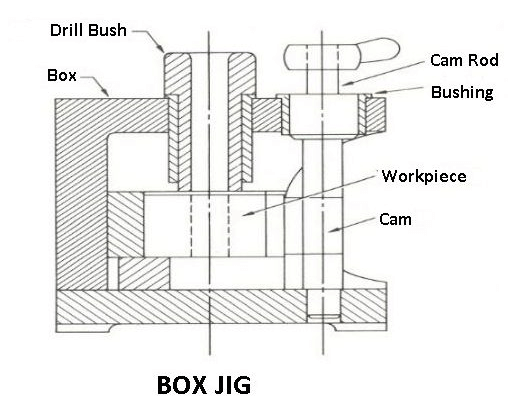
Versatile and comprehensive, box jigs offer:
Multi-angle machining capabilities in a single setup
Enhanced workpiece stability during operations
Improved accuracy for complex parts requiring multiple operations
Sandwich Jigs
Composed of multiple plates, sandwich jigs provide:
Secure clamping of irregularly shaped workpieces
Flexibility in accommodating various part sizes
Improved stability during machining operations
Trunnion Jigs
Designed for rotational positioning, trunnion jigs:
Allow workpiece rotation for multi-angle machining
Enhance efficiency in complex part production
Reduce setup time for operations requiring multiple orientations
What are Fixtures?
Fixtures are critical tools in manufacturing. They hold and secure workpieces in a precise position during machining operations. Unlike jigs, fixtures do not guide the tools but ensure that the workpiece remains stable, allowing accurate cuts and processes. They are essential in maintaining consistency, interchangeability, and efficiency in mass production.
Primary Function of Fixtures in Manufacturing
The main function of a fixture is to ensure the correct positioning of a workpiece relative to the cutting tool. By securely holding the workpiece, fixtures help reduce errors, increase machining speed, and improve the quality of finished products. They are commonly used in automated processes, where consistency and repeatability are vital.
Common Applications of Fixtures
Fixtures are commonly used in various machining operations, including:
Milling: Supports the workpiece for precise milling cuts.
Turning: Holds irregular components during lathe operations.
Grinding: Ensures the workpiece remains stable during grinding processes.
Boring: Keeps the part steady for internal hole machining.
Types of Fixtures
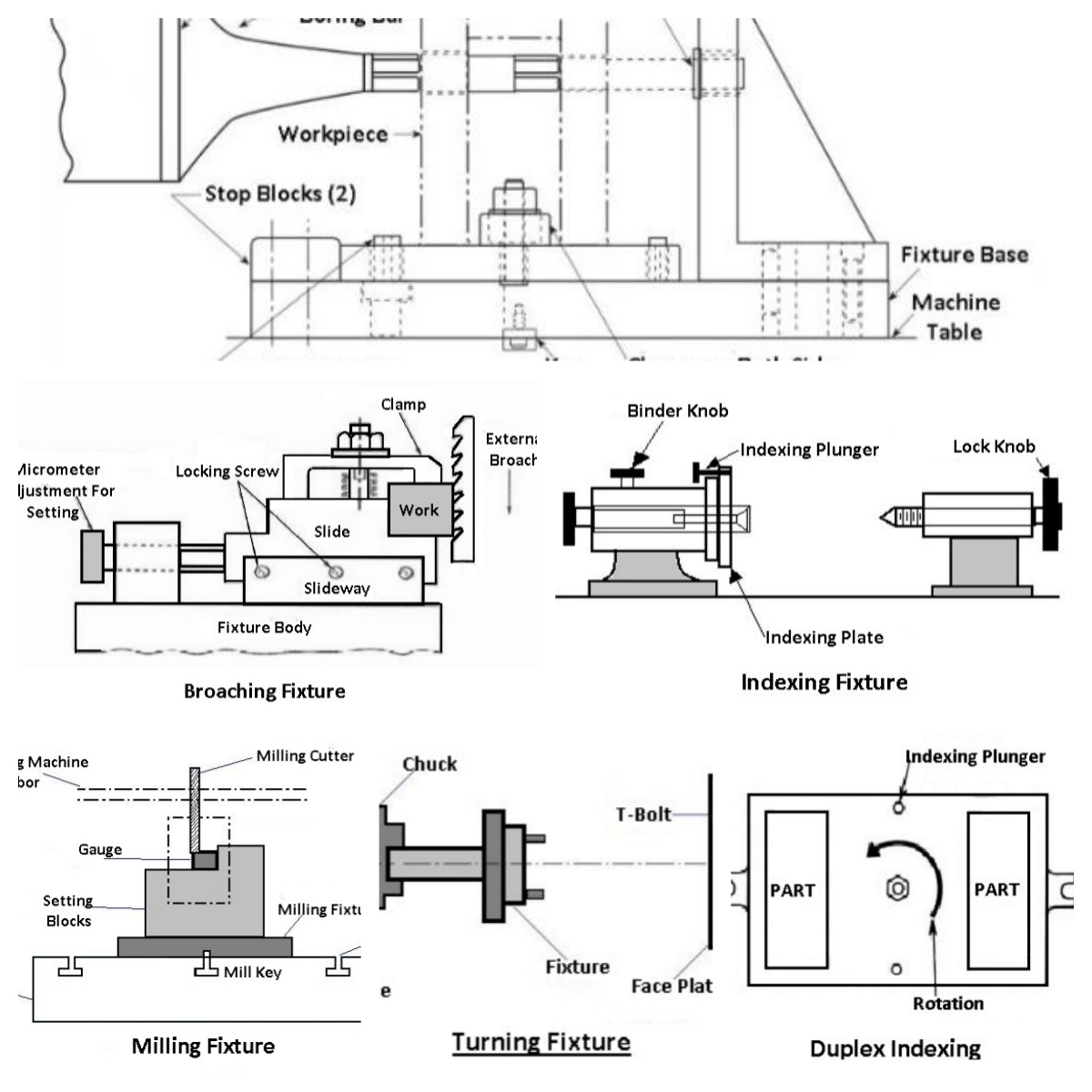
There are several types of fixtures designed for different machining operations:
Turning Fixtures: Used to hold components on a lathe. These fixtures ensure stability and minimize vibration during turning operations.
Milling Fixtures: Clamps the workpiece for accurate milling processes. They allow precise positioning and alignment relative to the milling cutter.
Drilling Fixtures: Designed for use in drilling machines. They hold the part securely while allowing precise drilling through guide holes.
Broaching Fixtures: Hold workpieces during broaching operations, used for shaping internal or external profiles.
Indexing Fixtures: Enable uniform spacing of machining on multiple surfaces. They are equipped with indexing mechanisms for precision.
Grinding Fixtures: Provide stability for parts during grinding. Magnetic chucks, mandrels, and vices are common examples.
Boring Fixtures: Specifically designed for boring operations, holding workpieces to ensure accurate hole positioning and depth.
Tapping Fixtures: Secure workpieces during internal threading operations, ideal for odd-shaped components.
Duplex Fixtures: Hold two identical parts simultaneously for dual machining operations, increasing production efficiency.
Welding Fixtures: Prevent distortion by securely holding components in place during welding processes.
Assembly Fixtures: Used to hold components together during the assembly of parts, ensuring precision alignment.
Main Elements of Jigs and Fixtures
Jigs and fixtures comprise several critical components, each playing a vital role in ensuring precision and efficiency during manufacturing processes. Understanding these elements is crucial for optimal design and utilization.
Body
The body forms the foundation of jigs and fixtures. It provides a stable platform for all other components. Typically crafted from durable materials like cast iron, steel, or aluminum, it withstands machining forces while maintaining rigidity. This ensures consistent accuracy across multiple workpieces.
Locating Elements
Locating elements precisely position the workpiece relative to the cutting tool or machine bed. They may include:
Pins
V-blocks
Custom-shaped surfaces
These components are critical for maintaining repeatability and ensuring part interchangeability in high-volume production environments.
Clamping Elements
Clamping elements secure the workpiece firmly throughout the machining operation. They can be:
Manual (e.g., screw clamps, toggle clamps)
Powered (e.g., hydraulic or pneumatic systems)
Designers must ensure sufficient holding force without distorting the workpiece or interfering with tool paths.
Grinding and Setting Elements
These elements guide cutting tools in jigs or assist in correct tool movement for fixtures. They often incorporate hardened surfaces or replaceable inserts to maintain accuracy over extended periods. Their primary function is to achieve consistent results across multiple machining cycles.
Indexing Elements
Indexing elements allow for precise rotation or repositioning of the workpiece for multi-faceted machining operations. They enable complex tasks to be completed in a single setup, reducing handling time and improving overall efficiency.
Positioning Elements
These components secure the jig or fixture to the machine table in the correct location and orientation. They ensure consistent positioning, critical for maintaining part-to-part accuracy in production runs.
Bushings
Primarily used in jigs, bushings guide cutting tools, particularly in drilling operations. Typically made from hardened tool steel, they resist wear and maintain accuracy over time. Bushings can be fixed, renewable, or removable, allowing for easy replacement or adaptation to different tool sizes.
| Element | Primary Function in Jigs | Primary Function in Fixtures |
| Body | Supports components, guides tools | Provides stable workpiece platform |
| Locating Elements | Position workpiece for tool guidance | Ensure precise workpiece orientation |
| Clamping Elements | Secure workpiece during operation | Hold workpiece against cutting forces |
| Grinding/Setting Elements | Guide tools for precise machining | Assist in correct tool movement |
| Indexing Elements | Allow multi-position machining | Enable complex part production |
| Positioning Elements | Align jig on machine table | Secure fixture to machine bed |
| Bushings | Guide cutting tools precisely | Not typically used |
Jigs and Fixtures Materials
Selecting the appropriate material for jigs and fixtures is crucial for ensuring optimal performance, longevity, and cost-effectiveness in manufacturing processes. Each material offers unique properties suited to specific applications and production requirements.
Hardened Steel
Hardened steel stands out as a premium choice for high-volume production environments. Its exceptional strength and wear resistance make it ideal for jigs and fixtures subjected to frequent use and high stress.
Key advantages:
Superior durability under repetitive machining operations
Maintains dimensional stability even under heavy loads
Excellent for precision applications requiring tight tolerances
However, its higher cost and weight may limit its use in certain scenarios.
Cast Iron
Cast iron excels in applications where vibration damping and stability are paramount. Its inherent properties make it a popular choice for large fixture bodies and bases.
Notable features:
Absorbs vibrations effectively, enhancing machining precision
Provides excellent thermal stability during prolonged operations
Cost-effective for large-scale fixtures
Its main drawback lies in its susceptibility to corrosion, necessitating proper surface treatment.
Aluminum Alloy
Aluminum alloys offer a compelling combination of lightweight properties and corrosion resistance. These characteristics make them particularly suitable for portable jigs and fixtures.
Advantages include:
Ease of handling and transportation in manual operations
Natural resistance to oxidation, reducing maintenance needs
Excellent machinability for custom designs
However, they may not be suitable for applications requiring extreme rigidity or wear resistance.
Engineering Plastics
Engineering plastics present a cost-effective alternative for specific jig and fixture applications. Their unique properties open up possibilities in specialized manufacturing scenarios.
Key benefits:
Electrical insulation properties for applications involving electronic components
Chemical resistance for use in corrosive environments
Low friction coefficients, reducing wear on workpieces
Their limitations include lower strength and heat resistance compared to metallic options.
| Material | Strength | Weight | Corrosion Resistance | Cost | Vibration Damping |
| Hardened Steel | High | High | Moderate | High | Low |
| Cast Iron | High | High | Low | Moderate | High |
| Aluminum Alloy | Moderate | Low | High | Moderate | Low |
| Engineering Plastics | Low | Low | High | Low | Moderate |
Key Differences Between Jigs and Fixtures
While both jigs and fixtures are crucial in manufacturing, they serve different roles. Understanding these differences helps manufacturers choose the appropriate tool for specific operations.
Primary Function
The primary function distinguishes jigs and fixtures. Jigs guide the cutting tool to the desired location on the workpiece, ensuring precision in operations like drilling and tapping. Fixtures, on the other hand, secure and support the workpiece during machining processes such as milling and grinding. They do not guide the tool but maintain the workpiece’s orientation.
Weight and Complexity
Fixtures are generally heavier and more complex than jigs. They must withstand higher forces and vibrations during machining, making them more robust. Jigs are often lighter because they primarily guide tools and require less material strength. This difference also impacts the cost, with fixtures typically being more expensive due to their complexity.
Design Considerations
Fixtures and jigs require different design considerations. Fixtures need to account for clamping strength, stability, and vibration resistance to handle heavy machining loads. Jigs, by contrast, focus more on precision and accuracy, as their primary role is guiding tools.
Contact with the Tool
Jigs come into direct contact with the tool to guide its path, often using bushings or templates to ensure accuracy. Fixtures, however, do not touch the tool. They only hold the workpiece securely, allowing the tool to move freely during the machining process.
Attachment to the Machine
Jigs are often handheld or lightly fixed on the machine, depending on the operation. In contrast, fixtures are firmly attached to the machine table using clamps or bolts to withstand the forces exerted during operations like milling or turning.
| Key Difference | Jig | Fixture |
| Primary Function | Guides the cutting tool | Holds and supports the workpiece |
| Weight and Complexity | Lighter, less complex | Heavier, more complex |
| Design Focus | Precision, tool guidance | Stability, clamping strength |
| Tool Contact | Comes into contact with the tool | Does not contact the tool |
| Machine Attachment | Handheld or lightly fixed | Firmly attached to the machine |
Benefits of Using Jigs and Fixtures in Manufacturing
| Benefit | Impact on Manufacturing |
| Increased Productivity | Reduces manual adjustments, increases throughput |
| Improved Quality and Accuracy | Ensures consistent positioning, improves finished product quality |
| Reduced Cost | Lowers labor and material costs, reduces scrap and rework |
| Accurate Tool Guidance | Provides precision in tool placement during machining |
| Increased Interchangeability | Produces identical parts with minimal variation |
| Reduced Wastage | Reduces material waste and scrap |
| Increased Safety | Secure clamping reduces risk of accidents |
| Reduced Manpower Needs | Automates workholding, reducing operator requirements |
| Shorter Production Cycle | Simplifies setup, reduces preparation time |
| Multi-Station Machining | Enables multiple processes on the same machine, improves utilization |
| Lower Inspection Costs | Ensures consistent quality, reducing need for frequent inspections |
| Facilitates Automation | Supports automated and digital manufacturing processes |
Jig and Fixture Design Considerations
Effective jig and fixture design is crucial for optimizing manufacturing processes. By adhering to key design principles, engineers can create tools that enhance precision, efficiency, and operator safety.
Alignment and Constraint
Perfect alignment ensures maximum accuracy in machining operations. However, over-constraining can introduce errors. Designers must strike a balance, using the minimum necessary locating points within allowable tolerances. This approach maintains precision while allowing for slight variations in workpiece dimensions.
Operational Efficiency
Simplifying designs and prioritizing single-handed operation when possible significantly improves efficiency. This approach reduces operator fatigue and minimizes the potential for errors during setup and use. Intuitive designs also decrease training time for new operators.
Minimizing Human Intervention
Automation in jig and fixture design reduces the need for manual intervention during machining processes. This not only improves consistency but also enhances safety by keeping operators away from potentially hazardous areas during operation.
Error Detection
Adopting geometries that highlight misalignment faults is crucial for quality control. These design features allow operators to quickly identify and correct issues before they result in defective parts. Visual indicators or physical stops can serve this purpose effectively.
Process Integration
Coordination with the entire manufacturing process flow is essential. Designers must consider how the jig or fixture fits into the broader production line, including:
This holistic approach ensures smooth transitions between stages and optimizes overall efficiency.
Material Selection
Choosing the right material is critical for jig and fixture performance. Factors to consider include:
Design Checklist
To ensure comprehensive consideration of all design aspects, engineers should address the following points:
Have we achieved optimal alignment without over-constraining?
Can the jig or fixture be operated with one hand?
Is human intervention minimized during the machining process?
Does the design highlight potential misalignment errors?
How well does this design integrate with our overall manufacturing flow?
Is the selected material optimal for our specific application?
Manufacturing Methods for Jigs and Fixtures
Choosing the right manufacturing method for jigs and fixtures is critical for ensuring their performance and cost-effectiveness. The method selected depends on factors like production volume, material requirements, and geometric complexity. Here are three common methods used to produce jigs and fixtures in manufacturing.
CNC Machining
CNC machining is a popular method for producing jigs and fixtures when precision and durability are paramount. It’s especially suitable for low-volume production where each piece needs to meet strict dimensional tolerances. CNC machining allows manufacturers to use various materials such as steel, aluminum, and high-strength alloys. This process delivers parts with high accuracy, making it ideal for applications that require custom jigs or fixtures with intricate designs.
Key Benefits of CNC Machining:
High precision and tight tolerances
Suitable for complex parts with custom features
Works with a wide range of materials
3D Printing
3D printing has revolutionized the production of jigs and fixtures, especially for low-production runs or complex geometries that are difficult or costly to machine. It enables rapid prototyping and customization at a lower cost. 3D printing is often used for producing fixtures with intricate internal structures, lightweight components, or those requiring quick adjustments. While it may not always match the strength of traditional materials, it offers significant flexibility in design.
Key Benefits of 3D Printing:
Cost-effective for low-volume or custom geometries
Faster production times for prototypes and small batches
Allows for complex, lightweight designs
Rapid Injection Molding
For high-volume production of jigs and fixtures, rapid injection molding is a preferred method. It is ideal for producing thousands of parts from engineering-grade thermoplastics. This process ensures that each part is consistent in quality and dimension. The cost per part decreases as volume increases, making it suitable for large-scale manufacturing. Rapid injection molding is used for fixtures that require strength, durability, and resistance to wear.
Key Benefits of Rapid Injection Molding:
Efficient for high-volume production
Consistent quality and dimensional accuracy
Suitable for parts made from durable thermoplastics
Applications of Jigs and Fixtures in Various Industries
Jigs and fixtures are essential tools in manufacturing processes across many industries. They improve accuracy, efficiency, and production speed, making them vital for high-quality manufacturing. Below are key industries that rely on jigs and fixtures.
Automotive Industry
In the automotive sector, jigs and fixtures play a critical role in assembly lines and manufacturing components. They ensure precise alignment during welding, drilling, and machining processes. Fixtures hold parts in place for repeatable and accurate manufacturing, contributing to the mass production of vehicle parts.
Key Applications:
Vehicle body welding and assembly
Drilling and machining of engine parts
Aligning components for high precision
Aerospace Industry
Aerospace manufacturing demands extremely high levels of accuracy and precision, which jigs and fixtures help achieve. Fixtures support the machining of complex parts, while jigs assist in the precise drilling and riveting of aircraft components. This ensures safety and reliability in aircraft construction.
Key Applications:
Riveting aircraft panels and structures
Machining of turbine blades and engine components
Alignment of critical assemblies
Electronics Manufacturing
In electronics manufacturing, jigs and fixtures are used to position delicate components and secure them during soldering or assembly. These tools help maintain consistency in mass production while preventing damage to sensitive electronic parts.
Key Applications:
Soldering and assembling circuit boards
Holding delicate components in place
Precision alignment for device assembly
Woodworking
Woodworking uses jigs for cutting, drilling, and shaping wood materials. Fixtures provide stability during machining processes, ensuring accurate cuts and consistent results. These tools are especially important in creating furniture, cabinetry, and other precision wood products.
Key Applications:
Dovetail cutting for cabinetry
Guiding tools for drilling and shaping
Clamping for precision joinery
Metalworking
Jigs and fixtures are integral to metalworking operations, from milling and turning to grinding. They help hold metal parts in place during cutting, shaping, and finishing processes, ensuring consistent quality and reducing production time.
Key Applications:
Machining parts on lathes and mills
Precision grinding and finishing
Multi-station metal fabrication
Mold Manufacturing
Mold manufacturing requires precision, especially when producing complex injection molds. Fixtures hold the workpiece steady during the milling or turning process, while jigs ensure exact tool placement for cutting complex shapes.
Key Applications:
Creating molds for plastic injection
Precision machining of intricate mold details
Clamping during tool path creation
Medical Device Manufacturing
Medical device manufacturing requires stringent quality control and high precision. Jigs and fixtures help ensure components are assembled accurately, especially for devices requiring exact tolerances and cleanliness.
Key Applications:
Aligning and assembling surgical tools
Holding small parts for cleanroom machining
Precision assembly of implantable devices
Consumer Electronics Manufacturing
In consumer electronics, jigs and fixtures ensure the fast and accurate assembly of small, high-volume products such as smartphones, tablets, and laptops. These tools streamline production lines and improve product consistency.
Key Applications:
Precision placement of small components
Assembly line fixtures for high-speed production
Positioning tools for device casing and screen installation
| Industry | Key Applications |
| Automotive | Welding, drilling, engine part machining |
| Aerospace | Riveting, turbine machining, structural alignment |
| Electronics | Circuit board soldering, component placement |
| Woodworking | Dovetail cutting, shaping, drilling |
| Metalworking | Milling, turning, grinding |
| Mold Manufacturing | Mold creation, machining intricate details |
| Medical Device Manufacturing | Precision assembly, cleanroom machining |
| Consumer Electronics | High-speed assembly, component alignment |
Conclusion
Jigs and fixtures play a crucial role in modern manufacturing, enhancing precision, efficiency, and productivity. From guiding tools to securing workpieces, these devices streamline operations across various machining processes. By understanding their types, materials, design considerations, and manufacturing methods, engineers can optimize production workflows. Whether utilizing CNC machining or 3D printing, the careful design and implementation of jigs and fixtures significantly improve product quality and reduce production costs, making them indispensable tools in today's competitive manufacturing landscape.


















